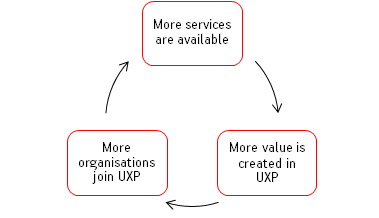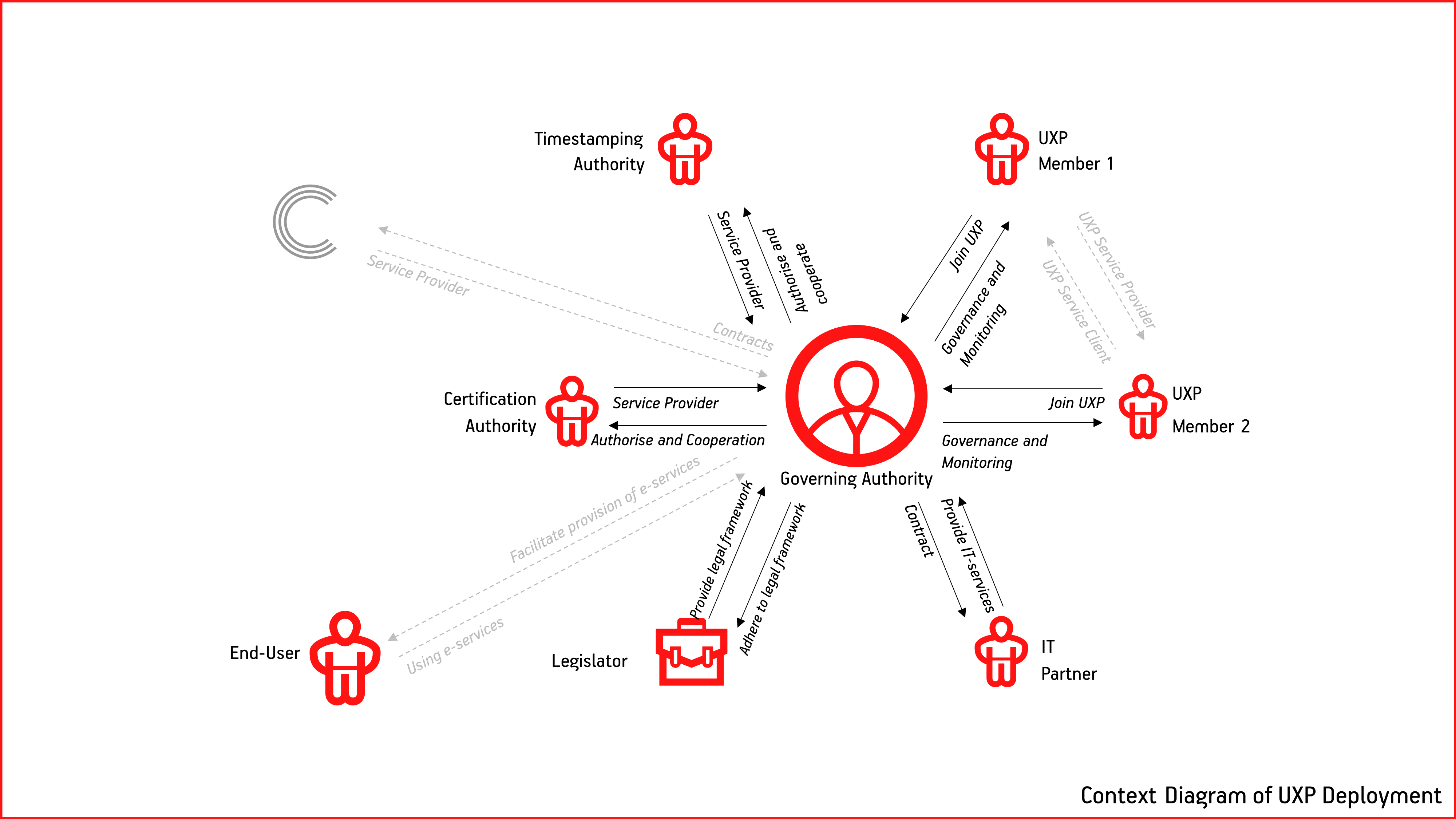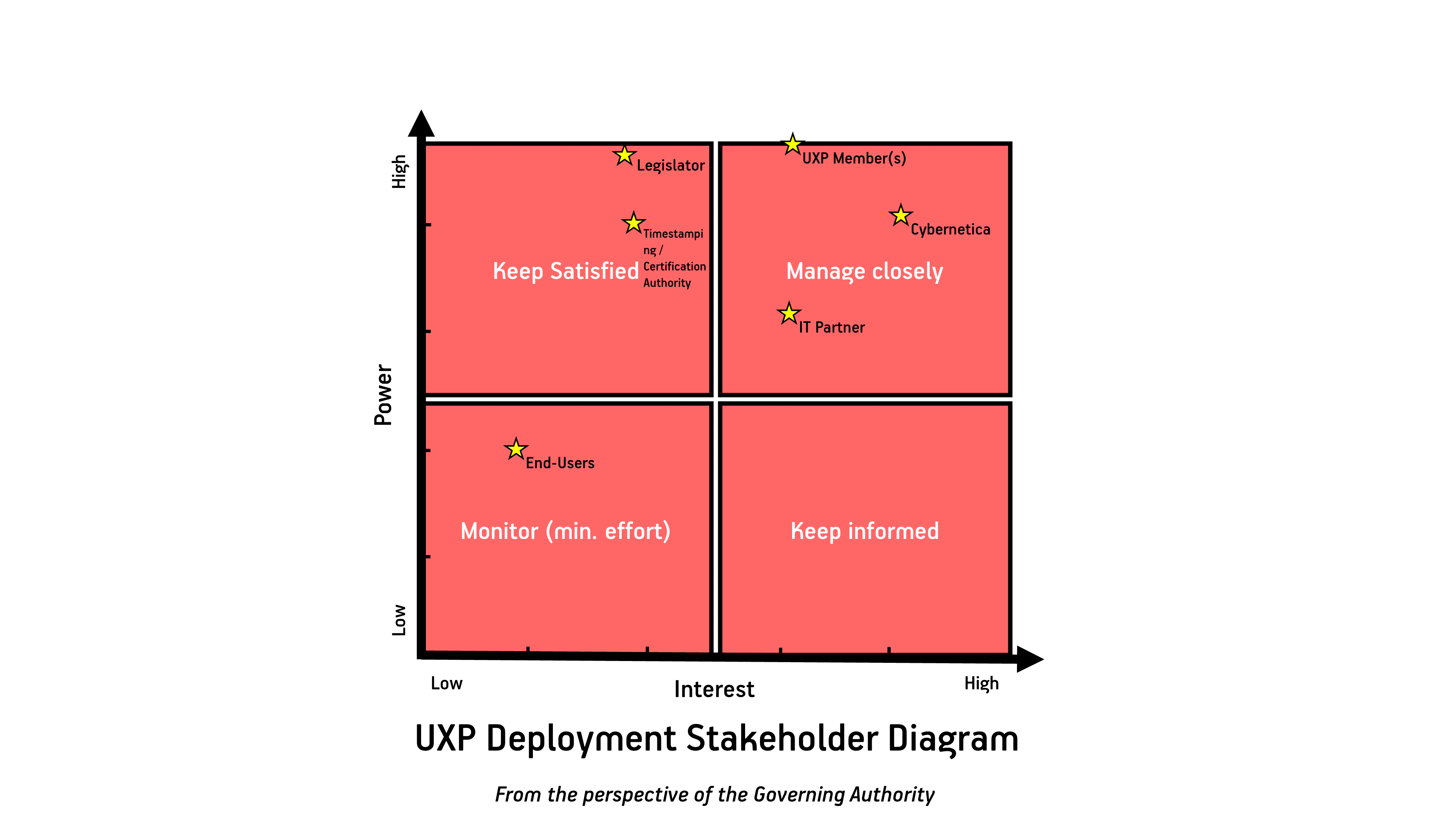Cybernetica’s UXP is a disruptive technology that works at the heart of digital transformation projects. As pointed out in the previous blog post, the adoption of new technology can have serious implications not only on the particular practical issue that it attempts to solve, but on the whole context that the technology is embedded in.
In that regard, UXP is special, since it functions as a platform that enables data exchange between multiple independent stakeholders, the platform members. The members can optimise business processes and build integrated e-services on top of the platform. UXP’s ability to integrate multiple members’ services is best activated by knowledgeable members, a supportive environment, and strong leadership. UXP’s potential and impact is well illustrated by the so-called market-network effect that combines the effects of networks and marketplaces (see NfX).

The logic is simple: the more organisations join the data exchange platform, the more services are made available and the more value is created in UXP. More services essentially mean more integrations between different member information systems, and more value reflects the time, resources, and finances saved through the integrations. However, whose responsibility is it to enable organisations to join and provide services via the platform?
The Governing Authority
The key stakeholder in a typical UXP deployment project is the Governing Authority. The Governing Authority is an entity that supervises and administrates local UXP deployment and operations. It coordinates the implementation of the new technology, establishes and administers membership rules, and issues certificates to UXP Members. Moreover, it monitors the data exchange operations and is responsible for updates and technical maintenance.
In our project for Ukraine, the State Agency for e-Governance of Ukraine takes the role of the Governing Authority, in Tunisia, it is the Ministry of Finance’s Informatics Centre, and in Benin, it is the Agency for IT Systems and Services (L’Agence des Services et Systèmes d’Information). They are all central IT institutions responsible for the implementation and maintenance of UXP. The Governing Authority does not necessarily need to be a public sector entity. For example, the Center for Medical Interoperability acts as the Governing Authority in the TOGETHER for Personal Protective Equipment Readiness project in the USA.
Thanks to its central role in a deployment, the Governing Authority is the main point of reference for the users of the data exchange platform - the members. Thus, not only from a technical, but also from an organisational and management standpoint, the Governing Authority bears the key responsibility in activating the potential of UXP in cooperation with other stakeholders.
Other UXP Stakeholders
While the Governing Authority is the active operator of the data exchange layer, it’s the UXP Members, that use the infrastructure for the optimisation of business processes or establishment of completely new e-services and business models.
Other involved stakeholders are the Timestamping and Certification Authorities. These are entities authorised by the Governing Authority to provide trust services to UXP members. The image below features a Legislator as well, since UXP needs to be embedded into the local legal context; this is particularly relevant regarding Data Privacy Regulations. An IT Partner is mentioned, as the Governing Authority might need to outsource some specific technical jobs. Cybernetica is included as a stakeholder, as we provide the technology and know-how. Last but not least, end-users are crucial as they will often be the ones benefiting directly from the optimisation or integration of UXP members’ business processes and services, even though they tend to have little direct impact on the UXP deployment itself.

Activating UXP Potential While Managing Stakeholders
While the image above is illustrative, it provides an idea of the management scope of UXP. Particularly, in the beginning of a UXP deployment, the Governing Authority plays the key role in managing the adoption of the technology to bring about the intended change. It needs to get members and other stakeholders on board, and services need to be built for the platform to thrive. We’ll take a closer look at this in next week’s blog post. For now, the UXP stakeholder diagram below indicates that every single stakeholder has an essential impact which needs to be considered by the Governing Authority in deploying UXP technology.

Of course, every deployment will be a bit different, but the diagram provides an idea of the importance of the core team around the deployment: UXP Members, Cybernetica and an IT Partner. They all need to be managed closely by the Governing Authority for different reasons. While the UXP Members’ interest in UXP might not be as high as Cybernetica’s and the Governing Authorities’, their power or influence is very high. Their commitment to data exchange via UXP is the key to activating the potential of the technology. Now, Cybernetica needs to be a close partner, as we have the experience and expertise in deploying UXP for our clients. Likewise, depending on the scope of the engagement, the contracted technical partnerships are of critical importance too.
The Legislator, Timestamping and Certification Authorities, and end-users should certainly be noted: while they will hardly be directly involved in the management of the UXP platform, they all play a crucial role considering the usage and functionality of UXP.
In the next article, we will outline what can be done on behalf of the Governing Authority in terms of ownership and leadership to make UXP-backed digital transformation a success story.
We can help you with advisory services for your UXP-backed digital transformation. Read more about it here: https://cyber.ee/products/secure-data-exchange/advisory/
Written by Tobias koch